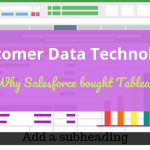
ABM and Choosing B2B Target Accounts
We talked about B2B Account-based Marketing (ABM) in our last DC Marketing Tech Talk. For those of you new to ABM, it’s a strategic approach where marketing and sales teams first select B2B target accounts. Up first, Triblio CMO Jason Jue explained ABM basics. Next, Demandbase ABM Strategist Jessica discussed how to plan for ABM.
Let’s back up and talk about what’s driving ABM adoption. Triblio gave us some noteworthy background:
- According to Sirius Decisions, 2% of leads close and 90% stall – this means a lot of waste- wasted money, sales time, and marketing time
- CEB research reports that B2B products have, on average, 6.8 decision-makers involved in the buying decision.
To reduce waste, improve reach to multiple decision-makers, and boost prospects with those key targeted accounts, ABM technologies are here to help.
ABM Personalization Serves an Optimized Website Experience
Triblio’s account-based personalization on your website is a boon for demand generation. It works because it delivers a relevant experience for lead generation or lead nurturing. Also, it allows a prospect to go from an optimized email experience to a website experience that is equally optimized. Furthermore, it also allows other prospects THAT you didn’t email to get the same personalized experience. Taken together, it speeds the sale.
As far as a good rule of thumb, Jason Jue wisely pointed out that ABM tactics vary by potential spend. Use automated tactics using firmographic profiles for smaller deal sizes. Use “semi-automated” sales and marketing touchpoints for medium-sized deals. Lastly, maximize the human touch and 1:1 personalization for large deal sizes.
Shift Marketing Budget to Fund Your ABM Strategy
Lastly, Jessica Fewless of Demandbase talked about how to get started.
For those who don’t know about Demandbase, it is a targeting platform that uses a patented technology to identify websites visitors. By using the network IP address, Demandbase services identify the company a visitor works for in real-time. Marketers can then target online ads to companies that fit criteria like exact company names, industry, revenue, customer status, or products purchased. This means that ads are never served to irrelevant audiences, thereby increasing the efficiency of the marketing spend.
Meanwhile, to start with ABM, B2B marketers need to:
1. Define target account list
2. Uncover where marketing challenges are
3. Identify under-performing marketing budget dollars
4. Determine when to budget for ABM
Jessica emphasized that ABM doesn’t necessarily require additional resources. Instead, it requires a shift of them. She suggested that it could be rolled up into a website redesign or marketing automation changes.
Finally, in a case study, Jessica described how content syndication, webinar sponsorships, digital advertising, and regional event marketing expense reductions free up about 45% of the marketing budget for ABM. In that same case study, prior to ABM, the company closed 9.6 deals for every 100 MQL (Marketing Qualified Leads). After implementing Demandbase ABM, they closed 26 deals within the same time frame. As a result of ABM, they nearly tripled their close rate.
So…both speakers made the point that ABM starts with the targeted account list.
It seems like there are lots of potential target accounts, so how do we make choices?
How Do We Choose ABM Target Accounts
It’s important to know one thing: the number of B2B target accounts in the USA is not as big as you think.
Before we choose those exact B2B target accounts, let’s start with some fundamental truths about the enterprise market. Check the US Business Census. There are about 18,000 companies with 500 or more employees in the USA. It’s probably not as as many as you thought.
Take a look at Forbes Global 2000, a list of publically traded companies based on market capitalization. Notice that number 2000 is SBA Communications. Also note its 2015 revenues of $1.64 billion. The fact is simple; there’s a limited number of very large companies and nearly every B2B technology wants to sell to them. No matter the technology or service, the top of the market is the top of the market. Hence, there’s a small number of them.
Do we really need to use a data provider like Lattice Engines or Radius to choose B2B target accounts? If you have good-sized budgets, using a predictive solution might have an ROI. If you’re a small company with a new technology or solution, it’s probably not the best place to start.
Choosing Initial B2B Target Accounts is Easy
Start with considering market drivers in different industries. Also, think about how the speed of decision-making varies within industries and firm sizes. Nothing can replace actually thinking. Hence, know who might need your product or service. Research if compliance requirements might drive sales. Consider whether certain industries can benefit from its features or functions more than others.
After choosing verticals, next think about how many new customers you can serve. How much supply do you have to meet created demand? If you’re still very small and rapid growing, be realistic. Think 18 to 36 months out. If you aim for about 100 closed deals over the next 3 years, then you probably need to start with a B2B target account list of about 400 to 500 firms.
In order to create that actual B2B target account list, start with understanding the population of companies. Some useful sources are DiscoverOrg or Hoovers. Once you see the population of companies, choose a mix of company sizes within selected verticals. As a result, you’ll build in different buying cycle lengths. Which can be helpful in building out the pipeline.
Once you have some experience marketing to your list — after about 6 months — refresh your ABM B2B target account list. Use your marketing automation and CRM data to remove closed accounts and to add new B2B account targets.
Armed with a track record, consider using a predictive analytics data provider to refresh your B2B target account list. They kick start your company to a new growth levels, especially outside the US market. Or expand your use of ABM technologies.
Give our case study on choosing B2B target accounts a quick read and we’re ready to answer questions if you want to know more.








